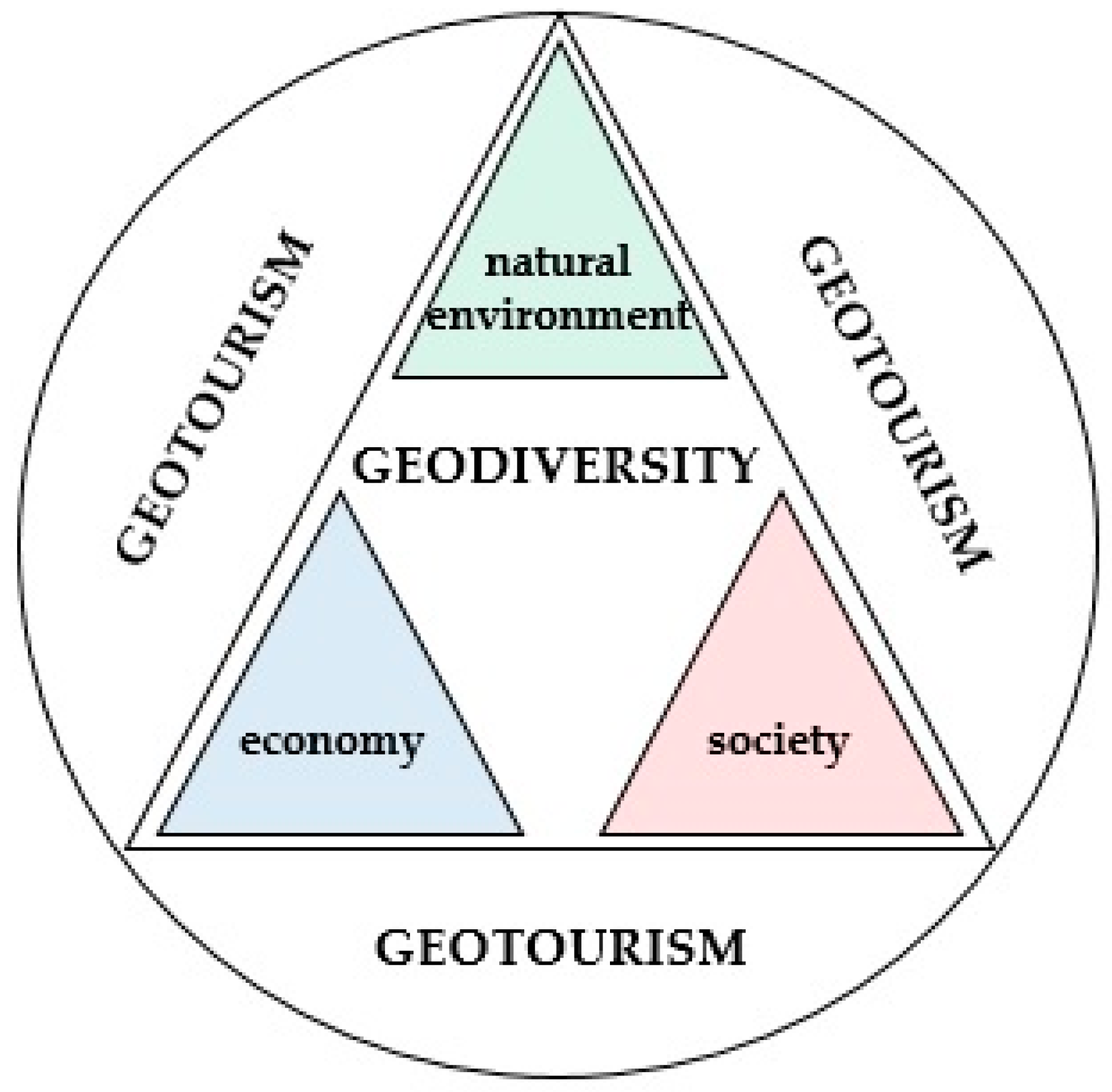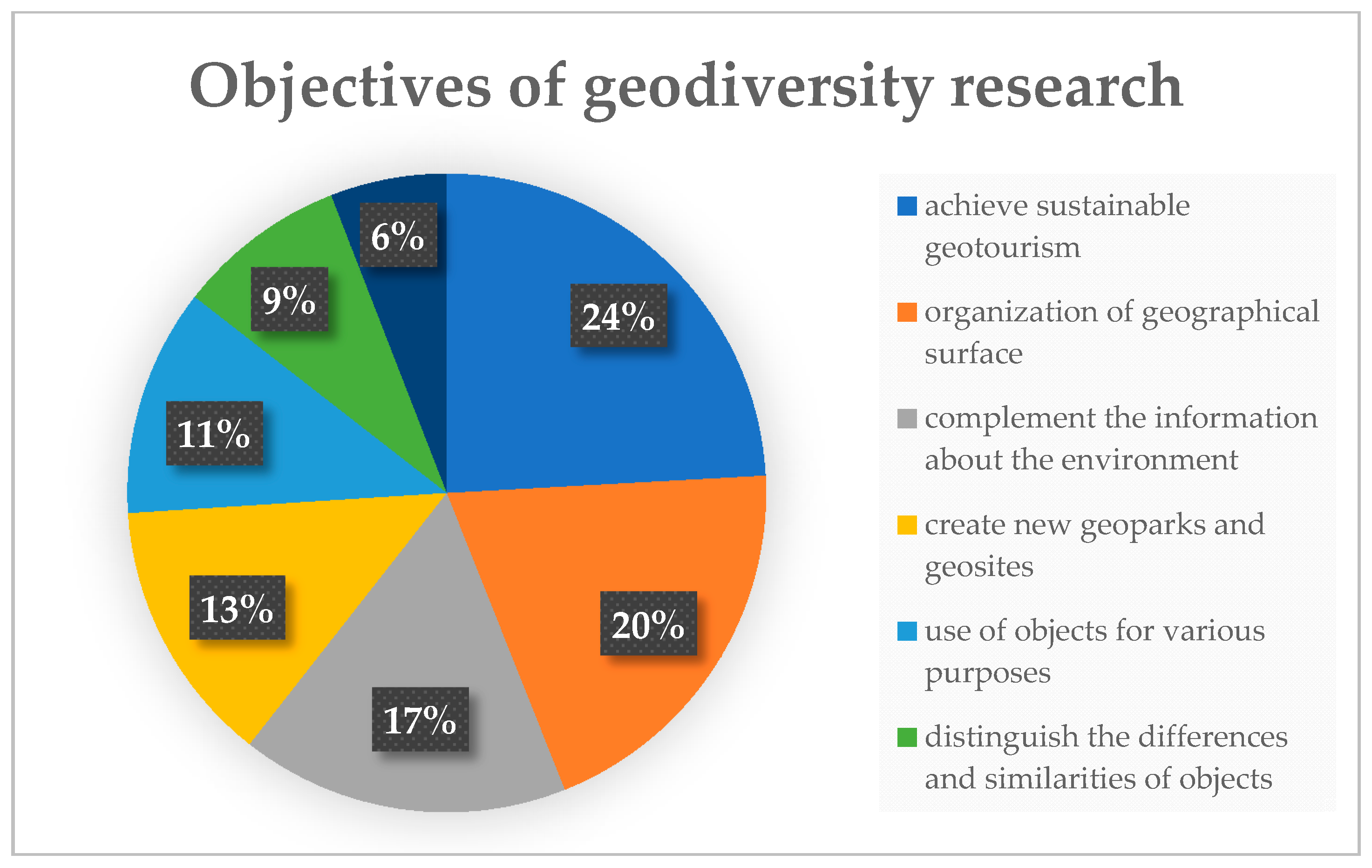Geodiversity Research Methods in Geotourism
Abstract
:1. Why Geodiversity Methods for Geotourism
1.1. Research Objectives in Geodiversity
1.2. The Most Decisive Features of Quantitative and Qualitative Geodiversity
2. Most Commonly Used Methods in Geodiversity
- are used to recognize terrain and its initial characteristics,
- allow to recognize other previously unknown features of natural objects,
- report on the condition of the natural environment,
- allow you to sort out the information you have so far,
- the basis for the further complex calculations.
- allow to distinguish the differences and similarities of objects,
- give to the objects a scientific character,
- use different values of objects for different purposes.
- allow for a better organization of geographical space,
- help in the promotion of sustainable development of geotourism.
2.1. Geodiversity Methodological Approach
2.1.1. Inventory of the Natural Environment in Terms of Geodiversity
2.1.2. Categorization of Geodiversity Characteristics (Quantitative and Qualitative)
2.1.3. Implementation of Geography Map and Selection of Basic Field and Ground Position
2.1.4. Assessment of Geodiversity
- Eg—is a number of physical features defined for given unit area,
- R—is a roughness coefficient of unit area,
- S—is the surface of unit area.
2.1.5. Visualization of Geodiversity Assessment
2.1.6. Assignation of Geodiversity Regions
3. Final Remarks
Conflicts of Interest
References
- Hose, T.A. 3G’s for Modern Geotourism. Geoheritage 2012, 4, 7–24. [Google Scholar] [CrossRef]
- Gray, M. Geodiversity: Valuing and Conserving Abiotic Nature, 2nd ed.; Wiley Blackwell: Chichester, UK, 2013. [Google Scholar]
- Thomas, M.F. A geomorphological approach to geodiversity—Its applications to geoconservation and geotourism. Quaest. Geogr. 2012, 31, 81–89. [Google Scholar] [CrossRef]
- Kozłowski, S. Geodiversity. The concept and scope of geodiversity. Prz. Geol. 2004, 52, 833–837. [Google Scholar]
- Brilha, J. Inventory and quantitative assessment of geosites and geodiversity sites: A review. Geoheritage 2016, 8, 119–134. [Google Scholar] [CrossRef] [Green Version]
- Hajduk, Z. Ogólna Metodologia Nauk; Redakcja Wydawnictw Katolickiego Uniwersytetu Lubelskiego: Lublin, Poland, 2012. [Google Scholar]
- Lazzari, M. Geosites, cultural tourism and sustainability in the Gargano National Park (southern Italy): The case study of the La Salata (Vieste) geoarchaeological site. Rend. Online Soc. Geol. Ital. 2013, 28, 97–101. [Google Scholar]
- Farsani, N.T.; Coelho, C.O.A.; Costa, C.M.M.; Amrikazemi, A. Geo-knowledge management and geoconservation via geoparks and geotourism. Geoheritage 2014, 6, 185–192. [Google Scholar] [CrossRef]
- Henriques, M.H.; Brilha, J. UNESCO Global Geoparks: A strategy towards global understanding and sustainability. Episodes 2017, 40, 349–355. [Google Scholar] [CrossRef]
- Kapera, I.; Różycki, P. Podstawy rozwoju geoturystyki na Wyspach Kanaryjskich ze szczególnym uwzględnieniem Lanzarote. Ekon. Probl. Tur. 2015, 29, 223–240. [Google Scholar]
- Forte, J.; Brilha, J.; Pereira, D.; Nolasco, M. Quantitative evaluation of geodiversity: Development of methodological procedures with application to territorial management. In Proceedings of the EGU General Assembly 2012, Vienna, Austria, 22–27 April 2012. [Google Scholar]
- Lima, E.A.; Nunes, C.J.; Costa, M.P.; Machado, M. Basis for the geological heritage management in the Azores Archipelago (Portugal). J. Integr. Coast. Zone Manag. 2014, 14, 301–319. [Google Scholar] [CrossRef]
- Kot, R.; Sobiech, M. Ocena georóżnorodności rzeźby terenu wybranych fragmentów krajobrazu młodoglacjalnego Pojezierza Chełmińsko-Dobrzyńskiego. Rocznik Świętokrzyski. Ser. B Nauki Przyr. 2013, 34, 77–92. [Google Scholar]
- Najwer, A.; Zwoliński, Z. Semantics and geodiversity assessment methods—Review and research proposal. Landf. Anal. 2014, 26, 115–127. [Google Scholar] [CrossRef]
- Reynard, E.; Perret, A.; Bussard, J.; Granger, L.; Martin, S. Integrated approach for the Inventory and Management of geomorphological Heritage at the Regional Scale. Geoheritage 2016, 8, 43–60. [Google Scholar] [CrossRef]
- Zwoliński, Z.; Najwer, A.; Giardino, M. Methods for assessing geodiversity. Geoheritage 2018, 19, 27–52. [Google Scholar]
- Lazzari, M.; Aloia, A. Geoparks, Geoheritage and Geotourism: Opportunities and Tools in Sustainable Development of the Territory. Spec. Issue Geoj. Tour. Geosites 2014, 13, 8–9. [Google Scholar]
- Kubalíková, L. Geomorphosite assessment for geotourism purposes. Czech J. Tour. 2013, 2, 80–104. [Google Scholar] [CrossRef]
- Miśkiewicz, K. Problemy badawcze georóżnorodności w geoturystyce. Geoturystyka 2009, 1–2, 3–12. [Google Scholar]
- Kot, R. Zastosowanie indeksu georóżnorodności dla określenia zróżnicowania rzeźby terenu na przykładzie zlewni reprezentatywnej Strugi Toruńskiej, Pojezierze Chełmińskie. Probl. Ekol. Kraj. 2012, 33, 87–96. [Google Scholar]
- Zwoliński, Z. The routine of landform geodiversity map design for the Polish Carpathian Mts. Landf. Anal. 2012, 11, 77–85. [Google Scholar]
- Serrano, E.; Ruiz-Flano, P. Geodiversity assessment in a rural landscape: Tiermes-Caracena area (Soria, Spain). Mem. Descr. Carta Geol. Ital. 2009, 87, 173–180. [Google Scholar]
- Órsi, A. Quantifying the geodiversity of a study area in the great hungarian plain. J. Environ. Geogr. 2010, 1–4, 19–22. [Google Scholar]
- Silva, J.P.; Pereira, D.I.; Aguiar, M.A.; Rodrigues, C. Geodiversity assessment of Xingu drainage basin. J. Maps 2013, 9, 254–262. [Google Scholar] [CrossRef] [Green Version]
- Miśkiewicz, K.; Doktor, M.; Słomka, T. Naukowe podstawy geoturystyki—Zarys problematyki. Geoturystyka 2007, 4, 3–12. [Google Scholar]


| Quantitative Geodiversity Features | Qualitative Geodiversity Features |
|---|---|
| geomorphological | educational/scientific value |
| paleontological | value of availability |
| mineralogical | value of object condition and threat |
| petrological | semantic value |
| stratigraphic | special qualities * |
| tectonic | economical value |
| hydrological | connection with biodiversity |
| hydrothermal | function in environment |
| volcanic | natural hazard risk |
| speleological | |
| sedimentary | |
| marine | |
| glacial |
© 2018 by the author. Licensee MDPI, Basel, Switzerland. This article is an open access article distributed under the terms and conditions of the Creative Commons Attribution (CC BY) license (http://creativecommons.org/licenses/by/4.0/).
Share and Cite
Kuleta, M. Geodiversity Research Methods in Geotourism. Geosciences 2018, 8, 197. https://doi.org/10.3390/geosciences8060197
Kuleta M. Geodiversity Research Methods in Geotourism. Geosciences. 2018; 8(6):197. https://doi.org/10.3390/geosciences8060197
Chicago/Turabian StyleKuleta, Magdalena. 2018. "Geodiversity Research Methods in Geotourism" Geosciences 8, no. 6: 197. https://doi.org/10.3390/geosciences8060197





